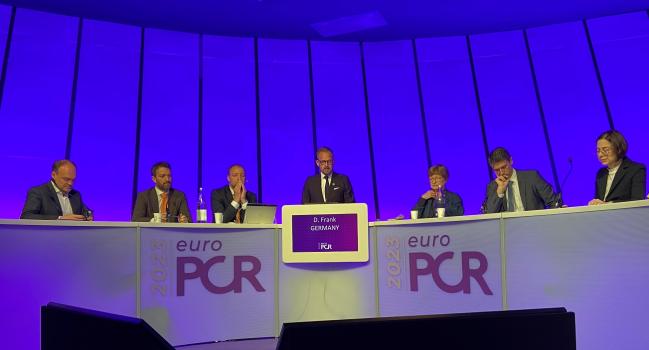Up and Away: TAVI Early Discharge Protocols Safely Cut Length of Stay
In Europe, where TAVI stays are generally longer, two studies showed hospital LOS could be cut by 1 to 2 days.

PARIS, France—Adopting a dedicated treatment protocol can get patients with aortic stenosis out the door after TAVI significantly faster, all without posing any risks, according to two complementary studies presented this week at EuroPCR 2023.
In the FAST-TAVI II study, which was presented by Eric Durand, MD (Rouen University Hospital, France), a training program aimed at staff involved in the care of TAVI-treated patients, significantly increased the percentage of patients discharged within 3 days compared with usual care and decreased hospital length of stay (LOS) by approximately 1 day.
With BENCHMARK, a similar streamlined TAVI pathway implemented by 28 European centers in seven countries cut LOS by 2 full days, as well as decreased the need for stays in intensive-, coronary-, and intermediate-care units. Derk Frank, MD (Universitätsklinikum Schleswig-Holstein, Kiel, Germany), who led the BENCHMARK study, said their pathway removes a little bit of freestyling to the discharge process.
“Usually, discharge might be made at the discretion of the resident in charge on a Saturday morning,” he told TCTMD. “Here, it’s just the fact we have a checklist in place to define the criteria when a patient can be safely discharged. It makes it easy—no discussion. The whole program is really all about structure.”
During his presentation, Durand said TAVI occupies a growing place in the management of aortic stenosis, and hospitals need to optimize care to deal with the growing backlog of patients “in a context where medical resources are constrained.”
In recent years, there has been a growing push to decrease hospital LOS for TAVI cases, with the COVID-19 pandemic spurring many hospitals to adopt rapid-discharge protocols, including getting some patients home the same day as their procedure.
Putting “Structure” in Place
The aim of the BENCHMARK study was to develop a set of best practices that could be easily implemented across different hospitals, including those in different healthcare systems. In total, researchers identified eight predefined practices to help streamline the discharge process. These included:
- Education and team alignment
- Education of patient and family
- Anticipated discharge date at admission (based on preprocedural risk stratification)
- Echocardiographic/angiographic check of puncture site at end of procedure
- Decision tree for determining need for new permanent pacemaker
- Early mobilization
- Daily visit by implanter to patient
- Criteria-based discharge
The best practices aren’t striking on their own but put together provide a framework for consistent early discharge, said Frank. Talking to the patient and family in advance helps inform their expectations about going home within a couple of days of receiving a new heart valve, which some patients need to wrap their heads around. Additionally, something as straightforward as early mobilization, as another example, requires a commitment from the patient and staff.
“Someone has to be there to mobilize the patient,” he said. “And when you’re doing four procedures per day, you have to have someone responsible on the nursing team to check for complications and then put the patient beside the bed so they’re walking again.”
The BENCHMARK study was conducted in France, Germany, Austria, Italy, Spain, Czech Republic, and Romania. After training and mentoring, investigators assessed LOS, ICU occupancy, patient satisfaction, and patient safety prior to and after the implementation of the BENCHMARK best practices.
Prior to the pathway, LOS was 7.8 days, with 5.3 days spent from the time of TAVI until discharge. After BENCHMARK, LOS was reduced to 5.8 days, with patients staying only 3.9 days from TAVI until discharge. Moreover, time in the general ward was reduced from 3.4 to 2.7 days while time spent in the ICU/CCU was cut from 1.3 to 0.8 days. Overall, LOS in any of the more intensive-care units outside the general ward decreased from 1.9 to 1.3 days.
Procedures also became more efficient during the study period, too. Use of local anesthesia/conscious sedation increased while procedure times were cut by 11 minutes. Most importantly, patient safety was not comprised. In-hospital complication rates were unchanged with the standardized protocol. In fact, the need for a pacemaker declined from 7.7% before BENCHMARK to 5.7% after its implementation (P = 0.042). There was no increase in hospitalization at 30 days, and no valve-related symptoms or worsening heart failure.
To TCTMD, Frank said patient satisfaction was extremely high, with more than 95% stating they were satisfied or very satisfied with their hospital care and interactions with staff. Overall, 91% said they prepared for discharge based on their discussions with the hospital team. In terms of what the future looks like, Frank speculated that hospitals will begin moving away from “intensified” care units after TAVI toward a recovery room and heart valve unit.
“At least in Germany, and I’m not sure about the other European countries, patients are really discouraged from moving when they’re in the intensive-care unit,” said Frank.
Tiffany Patterson, MD (Guy's and St Thomas' NHS Foundation Trust, London, England), one of the panel discussants during the hotline session, noted that many patients with severe aortic stenosis are presenting later because of long waiting lists. As a result, they’re deconditioned and frail, which contributes to the increased LOS because they’re not easily mobilized after TAVI. Such patients aren’t psychologically ready to go home, she added. For this reason, it may be important to focus on prehabilitation to get patients in shape—both mentally and physically—for a faster discharge.
Similar Improvements in FAST-TAVI II
FAST-TAVI II was a similar multicenter study evaluating an optimized-care protocol to reduce hospital LOS at 20 centers in France. Like BENCHMARK, the 10 participating hospitals randomized to the intervention were trained in the quality-of-care protocol and given 2 months to adopt the action plan. The comparator group included 10 hospitals who adhered to usual care.
The protocol included logistic quality-of-care measures (patient education, medical education, and early mobilization, among others) and those in place to prevent complications (algorithm-based management of conduction disorders, imaging-guided femoral puncture and closure, and measures to reduce bleeding and acute kidney injury).
The primary endpoint was proportion of patients discharged within 3 days, with study investigators showing a significant advantage with protocol-based care (58.1% vs 42.3%; P < 0.0001). Results were similar no matter what type of valve was implanted. Hospital LOS was cut from 4 days to 3 days, and there was no signal of risk assessed by 30-day mortality and readmission rates.
In terms of improvements in the 10 hospitals randomized to the protocol, the largest gains were seen in patient education and education of the medical team about early discharge, as well as early mobilization and use of the algorithm to manage conduction disorders. Durand said they allowed hospitals to use their own algorithm for managing conduction disorders, but recommended the protocol proposed by Josep Rodés-Cabau, MD, PhD (Laval University/Quebec Heart & Lung Institute, Canada), and colleagues published in 2019.
Going Home Too Soon?
Francesco Saia, MD (University Hospital of Bologna, Italy), one of the discussants during the hotline session, said the two studies show that the rapid-discharge protocol can be adopted in centers around the world. “We have solid data from many trials going in the same direction,” he said. Saia noted that the management of conduction disturbances can be the biggest delay in getting patients home.
The biggest overall challenge of the FAST-TAVI II protocol is getting completely buy-in from all the physicians, including interventional and general cardiologists, nurses, and other hospital staff, said Durand. “We need a huge team to decrease the length of stay,” he said.
During the discussion, Dirk Westermann, MD (Universitäts-Herzzentrum Freiburg/Bad Krozingen, Germany), said all hospitals need to adopt early discharge after TAVI, but played devil’s advocate, wondering if it’s possible to be too aggressive in the pursuit of saving money. Late conduction disturbances occurring beyond the hospital window could translate into a higher risk of hospitalizations or mortality, he said.
Durand agreed that safety is paramount, noting there was no difference in the risk of death from the time of discharge until 30 days in the control and intervention hospitals. Moreover, it would be impossible to keep all patients in hospital for 7-8 days to look out for a small number who might develop complete AV block.
Gregory Ducrocq, MD, PhD (Hôpital Bichat-Claude Bernard / Université Paris VII), said that if hospitals don’t push for earlier discharge with TAVI, this can translate into risks for other non-TAVI patients as hospital beds, including those in the CCU, are taken. “This can also be beneficial for other patients,” he said.
Michael O’Riordan is the Managing Editor for TCTMD. He completed his undergraduate degrees at Queen’s University in Kingston, ON, and…
Read Full BioSources
Durand E, Tchetche D, Leroux L, et al. Multicenter cluster randomized controlled study evaluating the efficacy of an intervention aimed at reducing the length of stay after transfemoral transcatheter aortic valve implantation: the FAST-TAVI II study. Presented at: EuroPCR 2023. May 17, 2023. Paris, France.
Frank D, Durand E, Lauck S, et al. BENCHMARK: a streamlined TAVI pathway with uncompromised safety in 28 European centers. Presented at: EuroPCR 2023. May 17, 2023. Paris, France.
Disclosures
- Durand reports honoraria or consulting fees from Edwards Lifesciences and Robocath.
- Frank reports research grants and honoraria from Edwards Lifesciences.





Comments